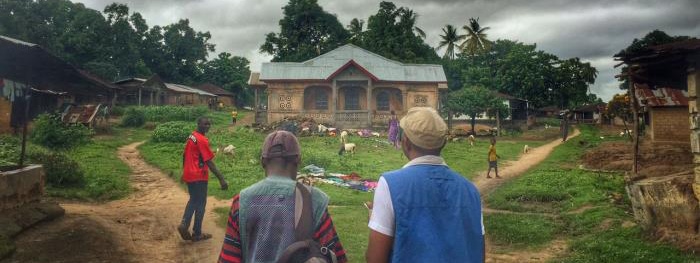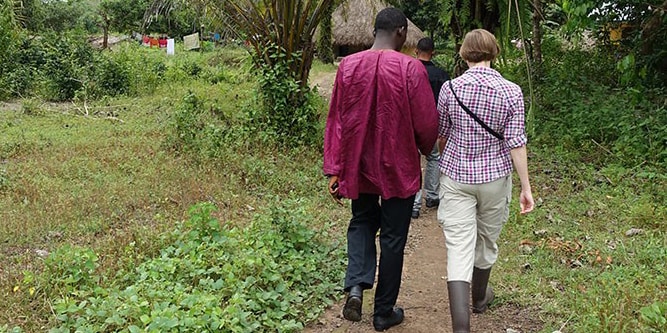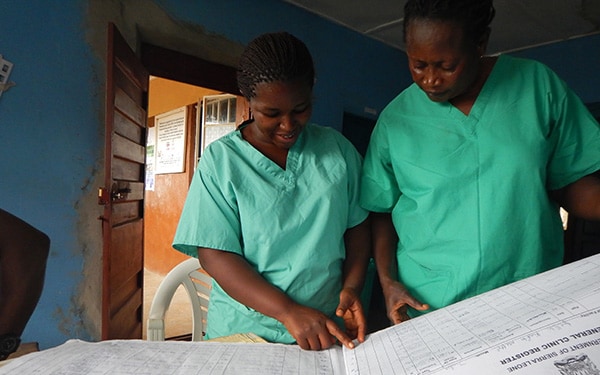CDC in Sierra Leone

Two case surveillance officers walk to the local clinic to assess surveillance practices, Tongo Walla, Sierra Leone, 2016. Photo by Luis Eduardo Torrens/CDC.
The Centers for Disease Control and Prevention (CDC) began working in Sierra Leone in the 1970’s, focusing on Lassa fever. In 2008, CDC began supporting Sierra Leone’s HIV response through the U.S. President’s Emergency Plan for AIDS Relief (PEPFAR). In 2015, CDC established an office in Sierra Leone to focus on global health security and the Ebola response. Since the COVID-19 pandemic began, CDC and the Government of Sierra Leone intensified efforts to strengthen laboratory, surveillance, emergency management, and workforce capacity to prevent and respond to disease outbreaks.
Global Health Security
CDC provides support and expertise across the 11 technical areas outlined in the Global Health Security Agenda (GHSA) Action Packages. These technical areas include disease surveillance, laboratory systems, workforce development, emergency management, immunization, and antimicrobial resistance. To strengthen Sierra Leone’s laboratory network, CDC provides training to laboratory technicians at the Central Public Health Reference Laboratory. CDC is also supporting establishment of a National Public Health Institute that will serve as a central structure for public health functions.
Sierra Leone has the highest maternal mortality rate in the world, and one of the highest mortality rates for children under five: out of 1,000 live births, over 13 mothers and 111 children under five die. To address this issue and prevent death among children under age five, CDC helped establish the Child Health and Mortality Prevention Surveillance (CHAMPS) network in partnership with the Ministry of Health and Sanitation (MOHS) and the Bill & Melinda Gates Foundation.
In 2021, CDC supported a regional meeting between Sierra Leone, Guinea, Côte d’Ivoire, and Liberia to strengthen cross-border and regional public health information sharing and increase coordinated surveillance, communication, and response
Laboratories in Sierra Leone can now detect and diagnose 10 key diseases, including COVID-19, Ebola, yellow fever, cholera, and influenza
CDC supported the development of the National Action Plan for Health Security and Joint External Evaluation update in 2018
CDC and the MOHS reviewed and updated the 1960s Public Health Act to provide a legal framework for establishing the National Public Health Institute
From 2021-2022, CDC and MOHS studied population mobility and identified priority sites for points of entry in three districts (Kono, Kailahun, and Falaba)
Disease Surveillance
After the 2014–2016 West Africa Ebola outbreak, CDC supported Sierra Leone’s development and implementation of an electronic reporting system for priority diseases. Sierra Leone is the first African nation to fully transition from a paper-based reporting system to an electronic system for weekly aggregate disease reporting at the health facility level. This landmark achievement increases efficiency in reporting, decreases data transmission turnaround time, and helps organize data for use in outbreak detection and response. Following the successful implementation of the electronic reporting system, CDC also supported establishment of a case-based disease surveillance information system (eCBDS) that reports case-level data and tracks epidemic-prone disease outbreaks. The electronic reporting system and eCBDS are key assets to Sierra Leone’s COVID-19 response.
Early in the COVID-19 pandemic, the CDC-supported eCBDS System was rapidly adapted as the case-reporting, contact tracing, vaccine tracking, and overall data management platform for the COVID-19 response. Sierra Leone’s eCBDS system:
- Enables consistent collection and timely transmission of COVID-19 case-based data from all the testing sites nation-wide
- Links laboratory test results with case data, reducing turnaround time
- Acts as a digital tool for data collection and surveillance of COVID-19-related deaths
- Captures screening data of travelers departing from and arriving at Freetown International Airport
CDC also works with partners to increase Information Technology (IT) infrastructure and human resource skills within the MOHS.
Sierra Leone is the first African country to fully transition from a paper-based disease surveillance data reporting system to a completely electronic format
Over 1,300 public health facilities report COVID-19 vaccinations through the CDC-supported electronic system
COVID-19
The first case of COVID-19 in Sierra Leone was confirmed on March 31, 2020. Previous global health security investments and decades of global partnerships in HIV, TB, malaria, polio, outbreak response, and pandemic preparedness built a strong foundation for Sierra Leone’s COVID-19 response. CDC supports response coordination, disease surveillance, diagnostic capacity, quarantine management, case investigation, IPC, and risk communication activities. Graduates from the FETP, Community Health Officer Management and Leadership Training Program (CHO MLTP), and the IPC certificate course serve critical roles in the COVID-19 response across communities, health facilities, institutions, and district health management teams.
CDC’s past investments and collaboration with Sierra Leone to build a strong and flexible disease surveillance system allowed the country to rapidly adapt the system to include COVID-19 case reporting, contact tracing, vaccine tracking, and data management for the COVID-19 response. CDC’s technical collaboration helps increase information sharing, consolidate reports for the COVID-19 Presidential Taskforce, and give strategic direction for Sierra Leone’s pandemic response.
CDC trained 400 health care workers on COVID-19 case management and treatment protocols
CDC helped train and mentor 162 health care workers to report COVID-19 clinical information through the Health Connect and District Health Information Software 2 (DHIS2) platforms
CDC supported COVID-19 contact tracing training for 410 community health workers and volunteers
In 2021, CDC supported the review and development of public health emergency response plans for COVID-19 at Lungi International Airport, Port of Freetown, and land borders
Field Epidemiology Training Program (FETP)

Epidemiologists use data to identify cases of Lassa fever and prevent the spread of the virus in Sierra Leone.
CDC helped Sierra Leone establish an FETP in 2016 to train health professionals in data collection, analysis, and interpretation that informs evidence-based decisions. Three levels of training—advanced, intermediate, and frontline—enhance national and local surveillance capabilities to investigate outbreaks before they become epidemics. FETP graduates throughout Sierra Leone conduct critical disease surveillance activities and outbreak investigations for infectious diseases like COVID-19 and viral hemorrhagic fevers like Ebola and Lassa fever. FETP graduates are key leaders in the COVID-19 response, providing trainings and developing COVID-19 case definition, case investigation, and contact tracing, quarantine, and points of entry protocols.
More than 280 graduates completed the Advanced, Intermediate, and Frontline FETP courses as of January 2022
Sierra Leone now has at least one FETP-trained epidemiologist per 200,000 people
As key leaders in Sierra Leone’s COVID-19 response, FETP graduates traced the source of infection and contacts for more than 56% of cases
42 FETP graduates trained as COVID-19 contact tracing supervisors
Community Health Management and Leadership

Community health workers review reports from a health facility in Kambia district.
CDC supported the MOHS to launch the Community Health Officer Management and Leadership Training Program (CHO MLTP) in 2016. Modeled after FETP, CHO MLTP is a six-month program with cohorts of 20-30 participants who work at community health centers across multiple districts. Participants receive in-class training reinforced by community projects that emphasize:
- Human resource management
- Using data for decision making
- Outbreak investigation management
- Health promotion
- Community engagement
- Interpersonal communication
- Quality improvement implementation science
As of August 2020, 185 community health officers across 14 of Sierra Leone’s 16 districts completed the Community Health Officer Management and Leadership Training Program (CHO MLTP)
10 participants completed the CHO MLTP training-of-trainers program
CDC worked with partners to integrate the CHO MLTP course into a local university curriculum
Infection Prevention and Control (IPC)
CDC first trained healthcare workers (HCW) in IPC during the 2014-2016 Ebola epidemic and continued supporting these trainings during the COVID-19 pandemic to enhance outbreak prevention, rapid detection, investigation, and response. IPC trainings help HCWs expand their knowledge, skills and competencies in providing quality healthcare services to patients admitted to COVID-19 centers. CDC also helped the MOHS establish IPC certification courses. Graduates of the certification courses continue to support the COVID-19 response within their communities, local health facilities, institutions, and district health management teams.
In addition to infectious diseases like Ebola and COVID-19, IPC is key to prevention and control of antimicrobial resistance. CDC supports implementation of surgical site infection (SSI) surveillance in 16 health facilities, working to increase the quality of SSI surveillance and prevent SSI and other healthcare-associated infections.
As of March 2021, 43 graduates of Sierra Leone’s Advanced IPC Certification Course serve as IPC mentors and supervisors at national and district levels
With support from CDC, MOHS trained health care workers from 36 hospitals (28 public/8 private) to implement IPC guidelines with monitoring and feedback
CDC worked with partners to review and update national IPC guidelines to include current information on COVID-19 and health care associated infections
Ebola
The 2014-2016 West Africa Ebola outbreak was the largest in global history. Out of all the countries affected by the outbreak, Sierra Leone experienced the highest number of deaths. CDC provided technical and strategic support in epidemiology, IPC, case management, health promotion, laboratory diagnostics and systems strengthening, emergency management, communications, and border health. CDC also supported research initiatives, including the Sierra Leone Trial to Introduce a Vaccine Against Ebola (STRIVE). CDC supported the establishment of the Sierra Leone Ebola/Epidemiological Database (SLED) to describe and understand Ebola morbidity and mortality and risk factors that contributed to the epidemic.
As of December 2021, the Sierra Leone Ebola/Epidemiological Database (SLED) helped more than 400 people find the graves of loved ones who died during the 2014-2016 West Africa Ebola epidemic
More than 700 CDC staff served on over 1,000 deployments to Sierra Leone during the 2014-2016 Ebola outbreak in West Africa
In 2021, CDC worked with Sierra Leone to complete an Ebola simulation exercise to identify gaps and prepare for the possibility of cross-border cases linked to a 2021 Ebola outbreak in Guinea
HIV and Tuberculosis (TB)
CDC has supported PEPFAR activities in Sierra Leone for 10 years. In 2020, Sierra Leone became an official PEPFAR country. CDC continues to support the National HIV Response in 15 healthcare facilities in accordance with UNAIDS’s 90-90-90 goals. CDC supports PEPFAR’s priorities in Sierra Leone, including:
- Increasing the quality of HIV and TB services
- Establishing high-quality laboratory systems to support HIV and TB testing for viral load, early infant diagnosis, and TB drug susceptibility
- Improving HIV-related health outcomes
- Strengthening HIV service delivery activities
- Decreasing new HIV infections
- Decreasing maternal and child mortality
- Supporting development of policy guidelines, standard operating procedures, and materials
- Training and education for nurses and midwives
- Workforce development for national trainers, mentors, and health facility staff
In 2022, PEPFAR’s goal is to test an additional 36,000 individuals, treat 32,000 individuals living with HIV/AIDS, and provide pre-exposure preventative treatment to an additional 4,000 clients. CDC and PEPFAR are also working to expand community-led monitoring of HIV services and address HIV-related stigma and discrimination.
In 2021, nearly 50,000 Sierra Leoneans participated in PEPFAR programs and over 1,200 sex workers enrolled in preventative treatment programs
As of January 2022, Sierra Leone’s CDC-supported National HIV Response is on track toward epidemic control by 2030
As of September 2021, over 6,100 people living with HIV (PLHIV) received antiretroviral treatment (ART) and over 3,700 PLHIV initiated ART across 15 health facilities
In 2021, 81% of patients receiving ART exhibited viral load suppression
Malaria
Malaria accounts for a large proportion of death and disease in Sierra Leone with more than 2.5 million cases and over 6,800 deaths reported in 2019. Through the U.S. President’s Malaria Initiative (PMI), a CDC resident advisor supports the National Malaria Control Program (NMCP). CDC works to enhance entomologic surveillance and insecticide resistance testing, increase data monitoring and usage, and reduce infant morbidity and mortality. CDC also supported NMCP’s adoption and use of bed nets treated with piperonyl butoxide (PBO). Compared to other bed nets used in Sierra Leone, PBO-treated bed nets are four times more effective against mosquitoes. With CDC support, Sierra Leone implemented the world’s first national net distribution campaign using the new generation of PBO-treated nets.
50 laboratory technicians participated in expert malaria microscopy training
In 2020, CDC helped Sierra Leone’s government procure and distribute 2.5 million nets treated with piperonyl butoxide (PBO)
- 4 U.S. Assignees
- 9 Locally Employed
- Population: > 7.9 million
- Per capita income: $1,670
- Life expectancy: F 56 / M 54 years
- Infant mortality rate: 75/1,000 live births
Sources: World Bank 2020, Sierra Leone; Population Reference Bureau 2021, Sierra Leone